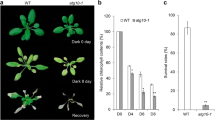Abstract
Free and bound acid phosphatase were investigated biochemically and electrophoretically in male sterile and fertile plants. Scutella at the 72-hr seedling stage and anthers with enclosed reproductive tissue at the premeiosis, meiosis, and mature developmental stages were tested. Biochemical data show that while the total amount of free acid phosphatase behaved similarly in fertile and sterile plants, specific activities decreased in fertile plants and remained unchanged or increased in sterile plants. Total amounts of bound acid phosphatase increased significantly in fertile plants while specific activities decreased. In sterile anthers both specific activity and amount of bound acid phosphatase decreased significantly (except cms-S). Electrophoretic results indicated that the basic form of the enzyme was very similar in each location.
Similar content being viewed by others
References
Barrett, A. J. (1969). Properties of lysosomal enzymes. In Dingle, J. T., and Fell, H. B. (eds.), Lysosomes in Biology and Pathology, Vol. 2, North-Holland, Amsterdam, pp. 245–312.
Beckett, J. B. (1971). Classification of male-sterile cytoplasms in maize (Zea mays L.). Crop Sci. 11724.
Brandenberger, H., and Hanson, R. (1953). Spectrophotometric determination of acid and alkaline phosphatases. Helv. Chim. Acta 36900.
Brewbaker, J. L., Upadhya, M. D., Makinen, Y., and MacDonald, T. (1968). Isoenzyme polymorphism in flowering plants. III. Gel electrophoretic methods and applications. Physiol. Plant. 21930.
Davis, B. J. (1964). Disc electrophoresis. II. Method and application to human serum proteins. Ann. N.Y. Acad. Sci. 121404.
deDuve, C. (1963). The lysosome. Sci. Am. 20864.
deVries, A., and Ie, T. S. (1970). Electron-microscopy of anther tissue and pollen of male sterile and fertile wheat (Triticum aestivum L.). Euphytica 19103.
Duvick, D. N. (1965). Cytoplasmic pollen sterility in corn. Adv. Genet. 131.
Edwardson, J. R. (1970). Cytoplasmic male sterility. Bot. Rev. 36341.
Erickson, J. R. (1967). Biochemical investigations of cytoplasmic male-sterility in spring wheat (Triticum aestivum L.). Agron. Abstr., Madison 8. Plant Breed. Abstr. 392108.
Hofstee, B. H. J. (1954). Direct and continuous spectrophotometric assay of phosphomonesterases. Arch. Biochem. Biophys. 51139.
Hunter, R. B., Hunt, L. A., and Kannenberg, L. W. (1974). Photoperiod and temperature effects on corn. Can. J. Plant Sci. 5471.
Laughnan, J. R., and Gabay, S. J. (1973). Reaction of germinating maize pollen to Helminthosporium maydis pathotoxins. Crop Sci. 13681.
Levings, C. S., III, and Pring, D. R. (1976). Restriction endonuclease analysis of mitochondrial DNA from normal and Texas cytoplasmic male sterile maize. Science 193158.
Lowry, O. H., Rosebrough, N. J., Farr, A. L., and Randall, R. J. (1951). Protein measurement with the Folin phenol reagent. J. Biol. Chem. 193265.
Manandhar, M. S. P. (1969). A biochemical study of developing maize lysosomes. Ph.D. dissertation, West Virginia University, Morgantown, W.V.
Miller, R. J., and Koeppe, D. (1971). Southern corn leaf blight: Susceptible and resistant mitochondria. Science 17367.
Nath, J. (1972). Correlative biochemical and ultrastructural studies on the mechanism of freezing damage to ram semen. Cryobiology 9240.
Nath, J., and Butler, L. (1971). Acid phosphatase during development of the black carpet beetle Attagenus megatoma (Fab.). Can. J. Biochem. 49311.
Nath, J., and Patt, J., Jr. (1970). Biochemical changes associated with freezing in ram semen. Cryobiology 6522.
Rhoades, M. M. (1931). Cytoplasmic inheritance of male sterility in Zea mays. Science 73340.
Shah, D. M., and Levings, C. S., III (1973). Characterization of chloroplast and nuclear DNA's of Zea mays L. Crop Sci. 13709.
Smith, D. R., Hooker, A. L., Lim, S. M., and Beckett, J. B. (1971). Disease reaction of thirty sources of cytoplasmic male-sterile corn to Helminthosporium maydis race T. Crop Sci. 11772.
Strivastava, H. K., and Sarkissian, I. V. (1970). Properties of wheat mitochondria: Study of substances, cofactors and inhibitors. Physiol. Plant. 2363.
Turbin, N. V., Palilova, A. N., Atranshenok, N. V., and Lyul'kina, E. I. (1970). Electron microscopic study of some stages of microsporogenesis in pollen of sterile and fertile plants. Dokl. Akad. Nauk SSSR 1911167.
Watson, C. V., Nath, J., and Nanda, D. (1977). Possible mitochondrial involvement in mechanism of cytoplasmic male sterility in maize (Zea mays L.). Biochem. Genet. 151113.
Author information
Authors and Affiliations
Additional information
Published with the approval of the Director of the West Virginia Agricultural Experiment Station as Scientific Paper No. 1573. Based in part on a dissertation by C. V. W. submitted to the Division of Plant Science, West Virginia University, Morgantown, West Virginia.
Rights and permissions
About this article
Cite this article
Nath, J., Watson, C.V. Acid phosphatase changes associated with development of male sterile and fertile maize (Zea mays L.). Biochem Genet 18, 377–387 (1980). https://doi.org/10.1007/BF00484250
Received:
Revised:
Issue Date:
DOI: https://doi.org/10.1007/BF00484250




